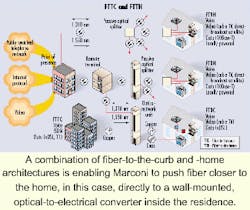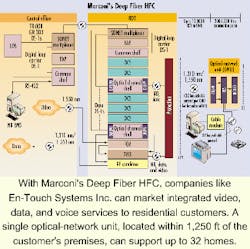Houston residential areas are getting 'fibered up' for the future
By ROBERT PEASE
APPLICATIONSWhile most optical access bandwidth providers pedal the benefits of fiber-optic technology to business center customers, En-Touch Systems Inc. (Houston) is targeting the emerging market of the residential consumer.
En-Touch was founded to provide advanced telecommunications services to quality master-planned communities, beginning in the Houston area. The company plans to serve up to 40,000 homes in the Houston area alone with a system of fiber-to-the-curb (FTTC) networks deployed in SONET-ring configurations, delivering bundled services to customers being overlooked by most of today's business-oriented providers.
"It was decided to go into the master-planned communities first," says Butch Gilmore, vice president of operations at En-Touch. "We figure we can catch the residential market first and, with the peripherals that build around that master-planned community, catch some of the businesses in the process. The niche is actually the large-scale communities, very few of which are being sought after by the CLECs [competitive local-exchange carriers] and other companies. We decided to key in on that market and offer the services we can provide and then build on that."Marconi (Pittsburgh), recently announcing the deployment of three million lines of FTTC architecture in North America, is supplying its Deep Fiber HFC solution for En-Touch's Houston projects. The system is not a traditional hybrid fiber/coax (HFC) network, since it is engineered around a traditional voice platform. The addition of broadband radio-frequency capability to the voice platform enables the delivery of broadcast video and cable modem data, based on a robust telephony platform.
"Additionally, a typical fiber node in an HFC architecture would be serving from 350 to 1,000 subscribers at once," says John Gibbs, director of product marketing for access systems at Marconi. "In our system, we are taking the fiber to the ONU [optical-network unit], which serves as few as eight to 32 subscribers. This architecture eliminates the shared-bandwidth problems of typical HFC networks."
The En-Touch/Marconi relationship has been ongoing. Prior to these new deployments, En-Touch had been using Marconi's traditional DISC*S digital-loop-carrier (DLC) copper platform to deliver voice services, along with a separate HFC network for video and data services. This approach resulted in maintaining two separate networks, whereas the rollout of Marconi's Deep Fiber HFC architecture combines the two networks into a single cost-effective solution. Gilmore wishes the optical infrastructure had come along sooner."Currently, we're copper from the node to the house and fiber from the node to our switch," says Gilmore. "But it's a fact that I'll no longer buy any copper infrastructure [for new builds]-it will be all-fiber going forward."
The single fiber uses WDM technology to transport voice and data across one wavelength and broadcasting video across another. Because of the WDM capability, the systems can be scaled. The capacity available on the system is limited only to today's limitations on fiber-optic transport, says Gibbs.
"To upgrade the system for future bandwidth demands, the optics at the HDT [host digital terminal] and ONU would simply need to be upgraded," says Gibbs. "No changes in the basic architecture or fiber plant would be required. With the addition of multiple wavelengths carrying multiple services, the capacity of a fiber-to-the-curb system is literally yet to be determined. Once the fiber is deployed to the curb, the service provider will never need to dig up the streets again, no matter what the bandwidth demands are for the future."
Years ago, it was argued that 1 Mbit/sec to every home, along with a dial-up modem, would be sufficient for years to come. But with new applications and services such as bidirectional streaming video, video telephony, and other bandwidth-intensive technologies, a good case is emerging for FTTC architectures, not to mention fiber-to-the-home (FTTH). In fact, Marconi recently announced a combination of its FTTC and FTTH products working in combination to drive fiber closer to the home.
The new architecture uses passive-optical-network (PON) technology and is based on Marconi's DLC technology. A single fiber terminates in the home at a wall-mounted optical-to-electrical converter (OEC). The OEC accommodates multiple carrier-class telephone lines, a 10Base-T Ethernet connection, and cable-television and direct-broadcast satellite video hookups.


